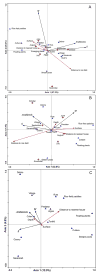Larval habitat segregation between the molecular forms of the mosquito Anopheles gambiae in a rice field area of Burkina Faso, West Africa
- PMID: 21501199
- PMCID: PMC3140611
- DOI: 10.1111/j.1365-2915.2011.00957.x
Larval habitat segregation between the molecular forms of the mosquito Anopheles gambiae in a rice field area of Burkina Faso, West Africa
Abstract
In West Africa, lineage splitting between the M and S molecular forms of the major Afro-tropical malaria mosquito, Anopheles gambiae (Diptera: Culicidae), is thought to be driven by ecological divergence, occurring mainly at the larval stage. Here, we present evidence for habitat segregation between the two molecular forms in and around irrigated rice fields located within the humid savannahs of western Burkina Faso. Longitudinal sampling of adult mosquitoes emerging from a range of breeding sites distributed along a transect extending from the heart of the rice field area into the surrounding savannah was conducted from June to November 2009. Analysis revealed that the two molecular forms and their sibling species Anopheles arabiensis are not randomly distributed in the area. A major ecological gradient was extracted in relation to the perimeter of the rice fields. The M form was associated with larger breeding sites mostly consisting of rice paddies, whereas the S form and An. arabiensis were found to depend upon temporary, rain-filled breeding sites. These results support hypotheses about larval habitat segregation and confirm the suggestion that the forms have different larval habitat requirements. Segregation appears to be clearly linked to anthropogenic permanent habitats and the community structure they support.
© 2011 The Authors. Medical and Veterinary Entomology © 2011 The Royal Entomological Society.
Figures



References
-
- Baldet T, Diabaté A, Guiguemde TR. Malaria transmission in 1999 in the rice field area of the Kou Valley (Bama), (Burkina Faso) Santé. 2003;13:55–60. - PubMed
-
- Bambaradeniya CNB, Edirisinghe JP, De Silva DN, Gunatilleke CVS, Ranawana KB, Wijekoon S. Biodiversity associated with an irrigated rice agro-ecosystem in Sri Lanka. Biodiversity and Conservation. 2004;13:1715–1753.
-
- Clark GG, Seda H, Gubler DJ. Use of the Cdc Backpack Aspirator for Surveillance of Aedes aegypti in San-Juan, Puerto-Rico. Journal of the American Mosquito Control Association. 1994;10:119–124. - PubMed
-
- Coluzzi M. The clay feet of the malaria giant and its African roots: Hypotheses and inferences about origin, spread and control of Plasmodium falciparum. Parassitologia (Rome) 1999;41:277–283. - PubMed
-
- Coluzzi M, Petrarca V, Di deco MA. Chromosomal inversion intergradation and incipient speciation in Anopheles gambiae. Bollettino Di Zoologia. 1985;52:45–63.
Publication types
MeSH terms
Grants and funding
LinkOut - more resources
Full Text Sources

